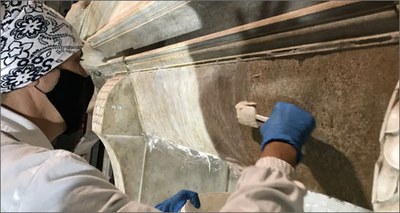Art: ENEA scientists unleash bacteria to clean Michelangelo's marbles
17/6/2021
Bio-restoration of the funerary monuments of the New Sacristy at the Medici Chapels in Florence
 Three bacterial strains from the ENEA in-house collection have been used for the restoration of Michelangelo's masterpieces in the New Sacristy at the Medici Chapels in Florence. The bio-cleaning intervention, featured also on the front page of the New York Times, was conducted by an all-woman team of scientists and restorers deploying 'grime-eating bacteria” to remove centuries of dirt besmirching the funerary monuments of Lorenzo de 'Medici, Duke of Urbino and Giuliano de' Medici, Duke of Nemours.
Three bacterial strains from the ENEA in-house collection have been used for the restoration of Michelangelo's masterpieces in the New Sacristy at the Medici Chapels in Florence. The bio-cleaning intervention, featured also on the front page of the New York Times, was conducted by an all-woman team of scientists and restorers deploying 'grime-eating bacteria” to remove centuries of dirt besmirching the funerary monuments of Lorenzo de 'Medici, Duke of Urbino and Giuliano de' Medici, Duke of Nemours.
The use of microorganisms and other natural substances, based on an accurate, safe, environmentally friendly biotechnological process, was patented by ENEA and developed thanks to its special collection of microorganisms, fungi, algae and viruses at the ENEA Casaccia Research Center near Rome, previously used successfully on stone materials in the Vatican Gardens.
"Selecting the appropriate bacteria was the hardest task", researcher Anna Rosa Sprocati explained. “First, we selected 11 bacterial strains capable of selectively removing the deposits without leaving residues and respecting the original marble. Then, we picked out the three with the best bio-cleaning performance and, among them, a microorganism isolated from the soil of a Sardinian mine contaminated by heavy metals, very effective in cleaning the marble ark of the Duke of Urbino, severely damaged in the past by the decomposition process which had released dark deposits along the entire base ”.
Before being spread on the marbles and after having being adequately 'starved' to make the treatment more effective or, where appropriate, grown on soils designed to enhance their specific capabilities, the bacteria strains were 'immobilized' in a special gel providing the right humidity and adequate consistency to the compress.
"It took us two days to cover the sarcophagus with the gel and bacterial cells pack," Chiara Alisi, researcher at the ENEA Laboratory of Observations and Measurements for the Environment and Climate, explained. “After two nights, the stains and deposits were removed without leaving residues, proving the procedure to be selective, gradual and safe for the marbles, damaged by previous drastic cleaning.
The archive of microorganisms of the ENEA Casaccia Research Center contains a special 'collection' of approximately 1,500 bacteria, fungi, algae and viruses, which is part of the Microbial Resource Research Infrastructure - MIRRI[1], a large network of European centers for the preservation of microbial biodiversity which contributes to the advancement of biotechnology and the bioeconomy.
"We gather spontaneous, useful and harmless bacteria, actual factories of enzymes and molecules to clean art works that, like this Italian Renaissance masterpiece, need constant protection and timely restoration interventions", pointed out the two reasearchers jointly with biologists Flavia Tasso, Giada Migliore and Patrizia Paganin of the ENEA Laboratory of Observations and Measurements for the Environment and Climate.
The collection stands out for its wealth of biodiversity and potential applications which include degradation of environmental contaminants, new products for a sustainable restoration of the artistic heritage, plant health, sustainable agriculture in arid soils, production of biomolecules for industrial, energy and food uses, production of bio-based molecules for the nutraceutical, cosmeceutical, pharmaceutical and green chemistry sectors, applications in the biomedical field for the development of innovative vaccines, diagnostic systems and targeted oncology therapy.
The project was implemented by the Bargello-Cappelle Medicee Museum, ENEA and CNR of Florence were in charge of the scientific coordination, Monica Bietti directed the restoration work, art restorers Marina Vincenti and Daniela Manna performed the restoration.
For more information please contact:
Chiara Alisi, Flavia Tasso, Giada Migliore, Patrizia Paganin and Anna Rosa Sprocati, ENEA – Laboratory of Observations and Measures for the Environment and Climate, chiara.alisi@enea.it - annarosa.sprocati@enea.it
European Patent EP 3046779 (IT, CH, DE, ES, FR, GB)
Video “Toccare Michelangelo 3”: https://youtu.be/bidIXuo4wnM
[1] http://www.mirri-it.it/index.php/associated-members-sep2019/
